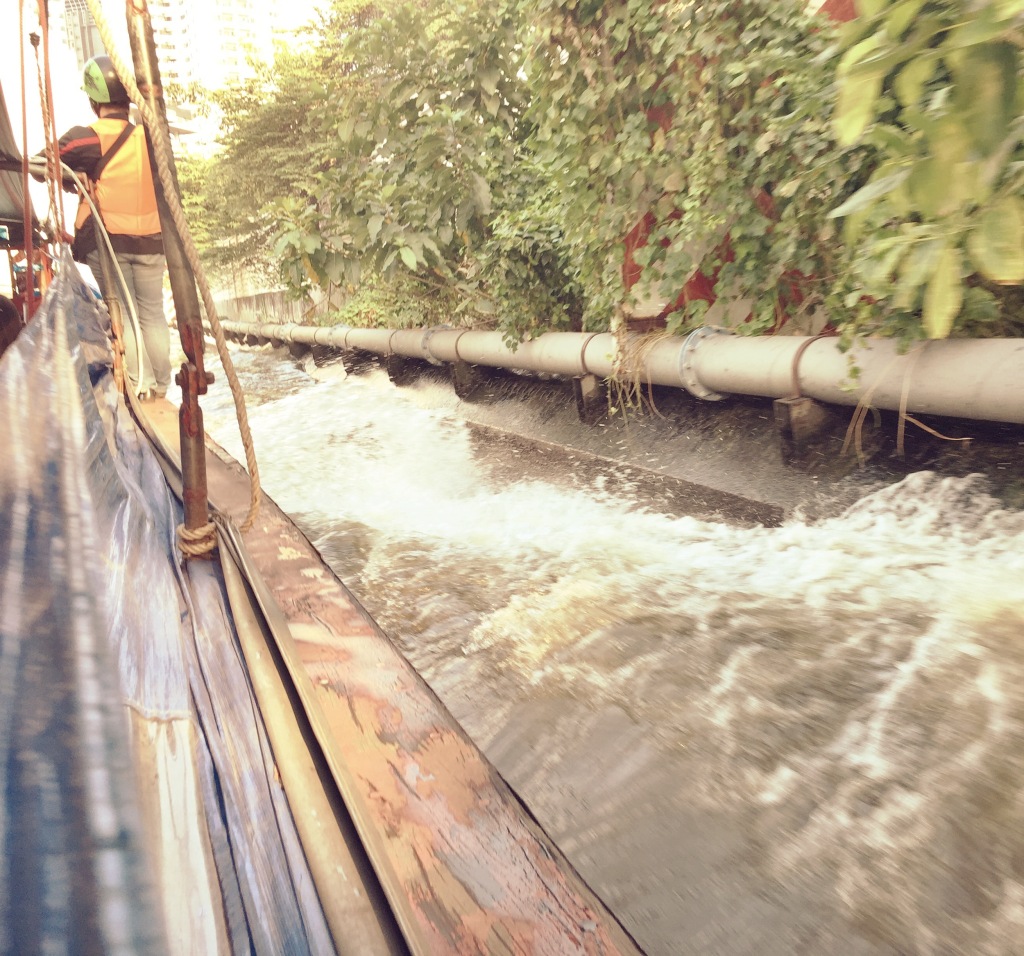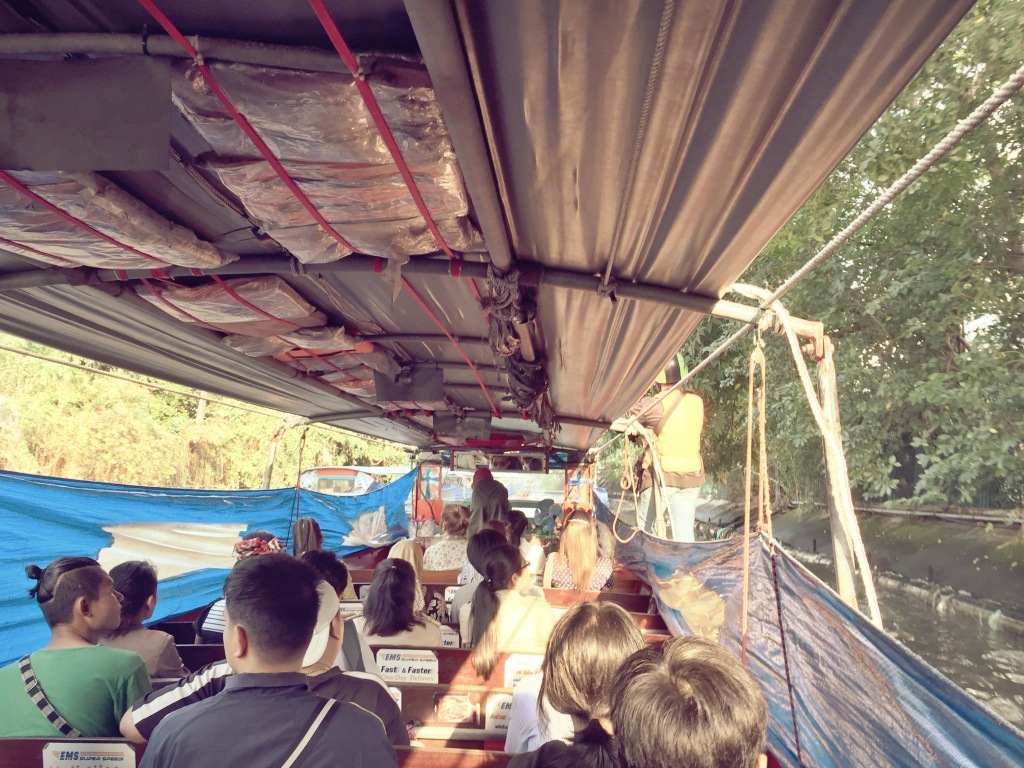Seventy percent of the Earth is composed of water making the land we live on seem to minuscule in proportion. I used to think that mainland was the epicentre of all life without giving much thought or appreciation to bodies of water. But after being in a coastal country that relies on water for its fisheries, tourism, and wildlife, I have further established an appreciation and embrace for water being a part of life. The nation’s capital, Bangkok, has provided many insights on how water helps connect people via Khlong Saen Saep. Once named the ‘Venice of the East’ for the high use of travelling by use of canals, Bangkok has grown exponentially to a point where rail, road, pedestrian paths, air, underground, and water are all used to an excruciatingly level of busy. For example look at this photo:
Cars line up in the most non-linear fashion and illustrate how big of a mess the roadways can be during the day. It is something I try to avoid at all costs, especially if there are more exciting way to get around.
The Khlong Saen Saep boat service run East and West right through the heart of Bangkok and adjoining neighbourhoods. The 18km route will take you along many major points of attractions like Siam Paragon, the various MTR and BTS stops, Chao Praya River, and much more. If it doesn’t get you there, it’ll get you close enough that a tuk tuk, motorbike, taxi, or walk can get you exactly where you need.
My first ride happened to be something that I just stumbled upon while roaming around the city. My friends and I were exploring Chinatown and made our way up to the Golden Mount – a Buddhist temple that was created on top of an 80 meter high artificial hill and is painted gold. The temple provided an amazing vantage point of the area, and from there I saw the skinny boats speeding up and down the narrow river. I knew right there and then that I had to ride one. Twenty minutes later I found myself hopping on to it just because that’s where the crowd was heading… and we didn’t know what else to do. As the boat took off, I browsed my phone to see what attractions were nearby. But that wasn’t necessary, because soon enough, the boat ride was an attraction on its own and allowed me to see a part of Bangkok that would be hard to do otherwise. I saw industrial sites, narrow residential complexes, boardwalks, Chinese neighbourhoods, markets, and much more (that only your eyes can really appreciate).

A Google Maps look at the routes and stops the Khlong Saen Saep boat service. Retrieved from khlongsaensaep.com.

A basic map outlining the various stops and nearby points of interest. Retrieved from khlongsaensaep.com.
From these maps it’s pretty clear that you can get pretty close to where you need, but I think that the destination is just as important as the journey there.
Pfanfa Leelard was our starting point during this boat trip. Prior to entering the boat my friends and I were roaming around Boriphat Road looking for the little village that makes and sells Monk’s Bowls. It was really cool to see how walking down this alley would lead us closer to the tiny clinking that was made by the locals, their hammer, and sheets of metal. Here are some excerpts from my Instagram account of this neighbourhood.
As I mentioned before, the Golden Mount is also nearby and basically straight North from the Monk Bowl neighbourhood on Boriphat. You won’t miss the hill that protrudes from the surrounding area. This whole area of Bangkok seems to focus on their crafts trades as you will see a lot of wood workers with intricately designed doors, furnishings, and little souvenirs. I came close to buying a little wooden ‘N’ for my namesake, but I really couldn’t think of a use for it.
On a different day I took the KSS boat to Bo Bae pier to get to Chinatown. I would not advise this path because it is a lot of walking through cheap markets, but maybe you’re into that sort of stuff. From the boat stop you’ll want to find the main road, Krung Kasem Road. It was really wild walking down the narrow pedestrian pathway that has many of the market tables jetting out, so you should watch out for that. From my observations much of the Chinese population has settled in this area (known as Samphanthawong District) since the development of the Grand Palace displaced them from their original settlement. Since I am of Chinese descent it’s always refreshing to see and hear Chinese influences around, whether it’s the food, the language, or just the people. If you pass by this area, try to pick up on the cultural nuances that make this area so special.
Back to the boat, as I travelled further East I kept seeing a diverse range of sights that I assume are unique to each neighbourhood.

The khlong also passes by many temples. The white building on the side is Wat Boron Niwat, where many monks call home. Yee, N. (CC). 2015.

The waters rush as boats pass by, and there are no buffer zones – just tall cement walls and the occasional greenery. Yee, N. (CC). 2015.

Corridors of housing line the Khlong, adjacent to several schools. There seem to be no frills here. Yee, N. (CC). 2015.
After passing by these sights I looked down at my phone and found somewhere I wanted to get off. Siam Paragon, CentralWorld, and all of the other malls that line this strip are available by getting off at Pratunam pier. Later that day I would venture down to Lumpini Park as well which you can read about in a later post.
As seen in the first picture of this blog, much of the streets are packed with people and their cars. But it is beyond belief along Ratchadamri Road by CentralWorld. The constant display of markets and events make this area hot and crowded. It is still valuable, since these malls play a significant role in the Thai lifestyle. They are air-conditioned paradises. Step in and all your worries of heat and being in a different culture will dissipate. You’ll begin to cool down, and feel like you’re back in a luxurious version of a mall you would find back home. A million times better than Yorkdale and Eaton Centre for you Torontonians.
I am happy that I ventured on to the KSS boat service, because without it I think I would know a bit less about Bangkok and its neighbourhood. Taking this [somewhat] traditional form of transportation gives you an intimate opportunity to see what roadways cannot. A look into the real Bangkok. For that I am well-pleased traveller.
If you are visiting Bangkok and are interested in following the destinations I’ve talked about in my blog visit: Guidetags.com’s Bangkok By River & Rail.
Click Here to open a new page to the Khlong Saen Saep’s super user-friendly and modern website to check out the various transfers to major points of interest.
With a cost of 8-20 baht for the ride (depending on how far you go) it’s more than worth it to take this mode of transportation during the rush hours that plague the roadways. The difficulty is that the admission collectors will not always understand which stop you want; as a result, charging you the maximum, which is still a steal when you factor in the distance and convenience of the boat service.

The view down the many rows of this long tail boat. On the right side you can see the fare collector traversing the side of the boat. Yee, N. (CC). 2015.
The official hours of operation as cited from their website are 5:30am-8:30pm during the weekdays, and 5:30am-7pm on weekends and holidays; but as the Thai culture is very informal don’t expect these times to be concrete. When in doubt trust what the crowd is doing, since the crowd will dictate whether the service is still running. And never be too shy to ask bystanders if you have any questions. As a major city the chance you will run into a person who can speak some level of English is high. Due to the informality of this service, it often runs in your favour. If they know that it is busy, the frequency of running boats will run earlier than the ‘every 20 minutes’ departure time.

A not so busy Saphan Hua Chang Pier shows the informality and functionality of the stops. Yee, N. (CC). 2015.
If you are travelling your way through Bangkok and you’re either looking for an efficient way of getting across the city, or you’re looking for a new take on the city that once was known for being the “Venice of the East”, it is worthwhile to pay the approximately $0.75CDN fare for a wild and wavy ride via Khlong Saen Saep.



